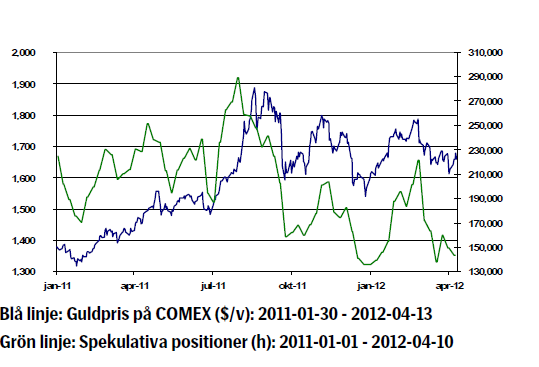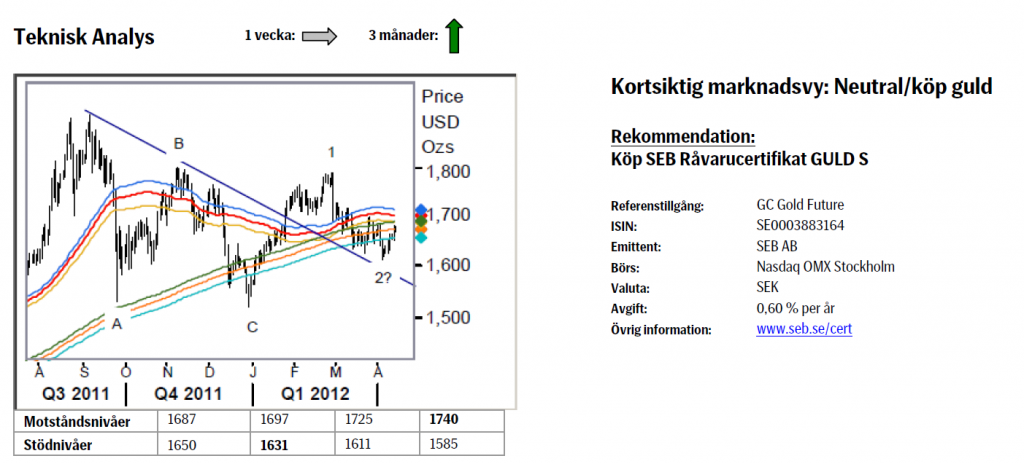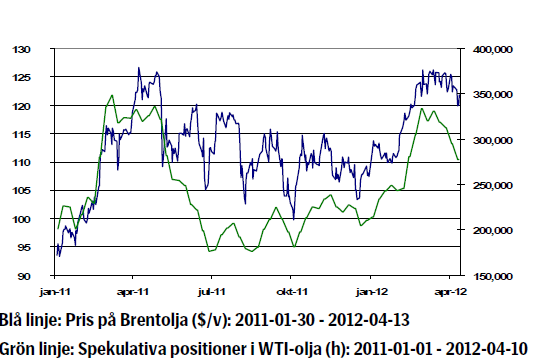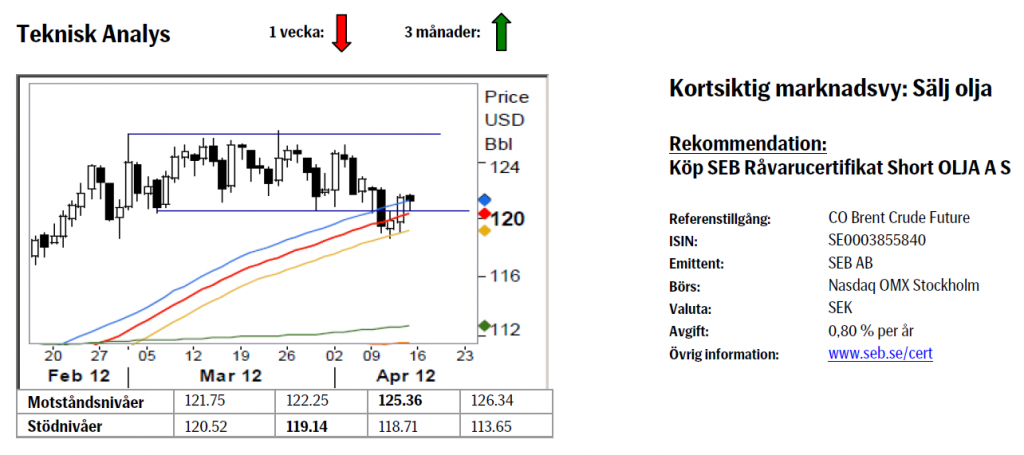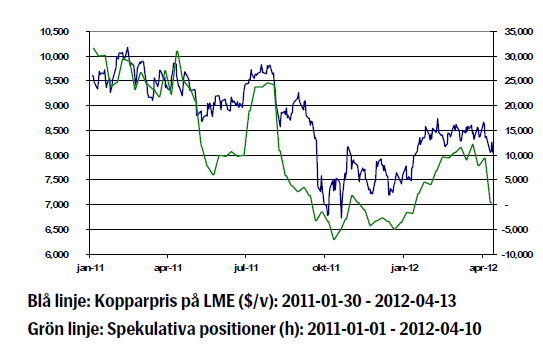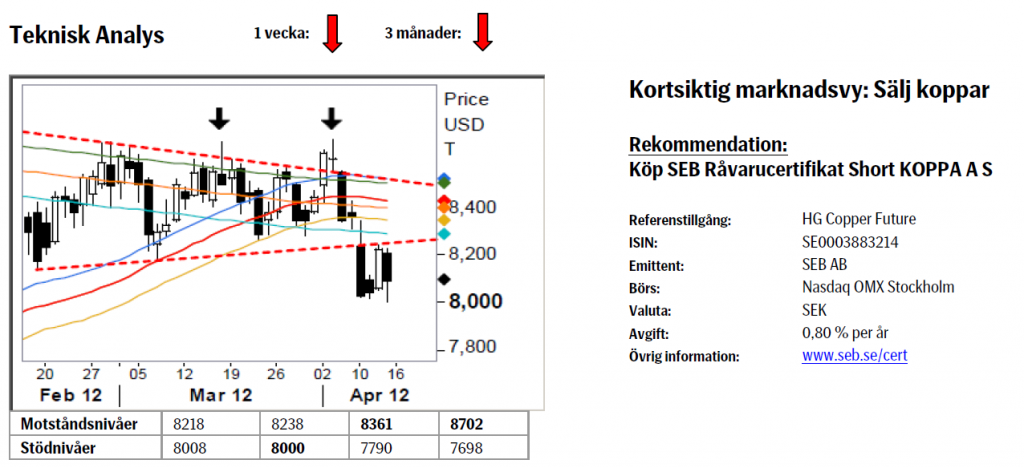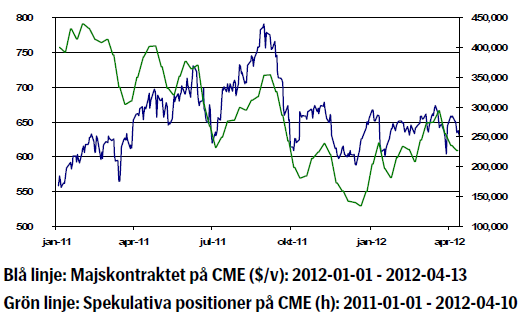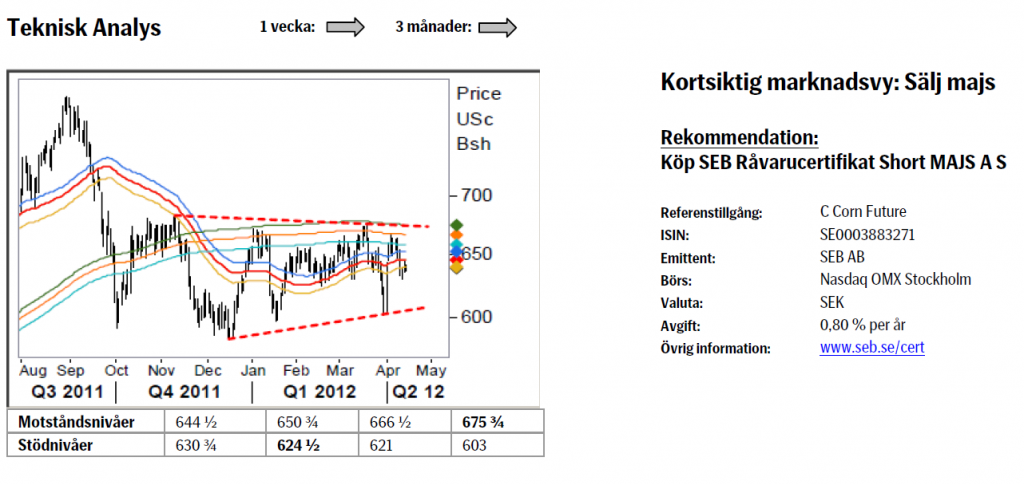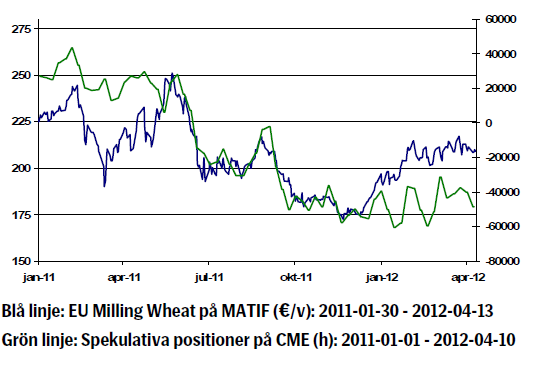Analys
SEB – Råvarukommentarer vecka 16 2012
Sammanfattning: Föregående vecka
- Energi: -1,14 %
UBS Bloomberg CMCI Energy TR Index
- Ädelmetaller: +1,25 %
UBS Bloomberg CMCI Precious Metals TR Index
- Industrimetaller: -2,8 %
UBS Bloomberg CMCI Industrial Metals TR Index
- Jordbruk: -1,85 %
UBS Bloomberg CMCI Agriculture TR Index
Kortsiktig marknadsvy:
- Guld: Neutral/köp
- Olja: Sälj
- Koppar: Sälj
- Majs: Sälj
- Vete: Neutral/sälj
Guld
- Guldpriset föll kraftigt i början av förra veckan men återhämtade sig senare, mycket till följd av en svagare dollar.
- USA presenterade sina senaste jobbsiffror, där nyanmälda arbetssökande var fler än förväntat med en uppjustering till 380 000 mot förväntade 355 000 personer. Detta väcker marknadens förhoppningar om monetära stimulanser. Dollarn sjönk på beskedet då en ökad likviditet ger en svagare valuta. Guldpriset steg som en konsekvens av att ökad likviditet ökar inflationsrisken.
- I Europa stiger oron över Spanien och Italiens stigande räntor. Avkastningen på spanska 10-åriga obligationer steg 18 baspunkter till 6 procent i fredags. ECB antydde att man överväger att köpa stadsobligationer för att motverka vad banken anser vara obefogat höga spanska räntor.
- På grund av en ökad Europeisk oro och en något högre sannolikhet för ytterligare stimulanser i USA förhåller vi oss försiktigt positiva till guldpriset kommande vecka.
- Teknisk Analys: Marknaden har sedan botten (bestående?) den fjärde april stadigt stigit mer eller mindre varje handelsdag och har nu tagit steget upp i den övre delen av 233-dagarsbandet. Uppgången är naturligtvis positiv ur vår synvinkel men tyvärr för liten för att utlösa någon signal. För att detta ska ske krävs som tidigare att vi åtminstone bryter mönstret av fallande toppar dvs. en uppgång över 1697.
Olja
- Priset på Brentolja föll med 0,75 procent under förra veckan. Iran med sitt eventuella kärnvapenprogram fortsätter att oroa omvärlden. International Energy Agency (IEA) förväntar sig att Irans oljeexport kommer att minska med 950 000 fat om dagen när embargot nått sin fulla styrka.
- Saudiarabiens oljeminister uttalade sig förra veckan om utvecklingen hos oljepriset och klargjorde att han inte är nöjd med den höga nivå som nu råder men tror att det kommer bestå under 2012.
- Konflikten mellan norra och det nu självständiga södra Sudan riskerar att eskalera till ett inbördeskrig. 300 000 fat olja per dag från södra Sudan når inte längre världsmarknaden som en konsekvens av denna konflikt.
- Statistiken från Kina la sordin på börsstämningen förra veckan, där kinesisk BNP steg med 8,1 procent på årsbasis under första kvartalet. Det var den lägsta siffran på tre år och nästan en procent lägre än siffran för Q4 2011. Enligt Blombergs prognosenkät hade analytikerna räknat med att BNP skulle öka med 8,4 procent.
- Department of Energy (DOE) rapporterade förra veckan att oljelagret steg 2,8 miljoner fat, mot förväntade 2 miljoner fat. Detta är en säsongsmässig ökning på grund av att raffinaderier gör underhållsarbete.
- Teknisk Analys: Marknaden bröt som förväntat ned ur toppformationen men har hittills fångats upp av köpare i 55dagars bandet. Det är möjligt att vi kommer att få se en hel del stötande o blötande innan nästa rörelse kommer. Men så länge vi inte stiger över 125,36 (bekräftelsepunkt för nya toppar) bör vi i slutändan falla ned igenom 55-dagarsbandet.
Koppar
- Kopparpriset föll totalt 0,13 procent förra veckan, där det största fallet kunde observeras på tisdagen då priset föll fyra procent efter negativa arbetslössiffrorna från USA och en nyväckt oro för den europeiska skuldsituationen. Osäkerheten kring det ekonomiska läget i Kina skapar ytterligare turbulens.
- Världsbanken sänker sin prognos för Kinas BNP-tillväxt i år till 8,2 procent, från tidigare 8,4 procent. Denna prognos kan jämföras med den faktiska siffran för kinesisk BNP-tillväxt under första kvartalet, vilken motsvarade en årlig tillväxt på 8,1 procent. Världsbanken säger vidare att det är möjligt att Kinas ekonomiska tillväxt sjunker till 13-årslägsta i år då en långsam global återhämtning minskar landets export och tillväxten för inhemska investeringar och inhemsk konsumtion minskar.
- Skulle landet sänka både styrränta och bankernas reservkrav i syfte att lätta på krediterna skulle det på sikt påverka kopparpriset positivt, men kortsiktigt ser vi en fortsatt risk på nedsidan.
- Som man kan se i grafen till vänster har spekulanter kraftigt minskat sina positioner i koppar i samband med de senaste veckornas nedgångar.
- Teknisk Analys: Brottet vi varnade för har nu materialiserats och ytterligare nedgångar förväntas inom kort. Innevarande studs/korrektion förväntas vända ned ifrån den brutna trendlinjen och därigenom bekräfta och validera brottet.
Majs
- Med bakgrund av den goda starten på den amerikanska majssådden är trycket på majspriset för närvarande helt klart negativt.
- Onsdagens WASDE-rapport från det amerikanska jordbruksdepartementet (USDA) bjöd inte på några större överraskningar. Att den globala lagernivån skulle justeras ned något jämfört med för en månad sedan indikerades redan vid månadsskiftet mars/april.
- Enligt USDA beror förändringen primärt på en nedjustering av de ingående kinesiska lagren 2012, där foderanvändandet i Kina under slutet av 2011 var högre än vad man tidigare antagit. Kina är en av världens största konsumenter av spannmål, där en väsentlig del av detta går till djurfoder.
- Efter att ha handlats sidledes under veckan föll priset under fredagen, detta på gynnsamma väderförhållanden i de majsproducerande staterna i USA samt oro för den globala tillväxten.
- Fredagens statistik från Kina visade på en långsammare tillväxt än vad marknaden hade förväntat sig. Vidare har den kraftigt ökade upplåningskostnaden för Spanien skapat oro för landets förmåga att på egen hand hantera sina skulder.
- Fundamentalt finns det för närvarande inte mycket som talar för högre priser den kommande veckan. Goda produktionsförutsättningar, oro för minskad efterfrågan från Kina samt en generell riskaversion i marknaden gör att vi bibehåller vi vår säljrekommendation för majs.
- Teknisk Analys: Även framgent gäller att ett brott under 624 ½ eller över 675 ¾ behövs för att utlösa någon form av riktningsinformation (vågmönstret i 60 minutersgrafen håller dock nedsidan för mer trolig). Till dess håller vi fast vid en neutral vy.
Vete
- Förra veckan var rejält slagig för kvarnvetet i Paris. Exempelvis kunde vi under tisdagen se hur handeln startade runt 208 EUR/ton, för att under mitten av dagen ligga på 212,5 och slutligen handlas ner till begynnelsenivån igen . Denna tendens höll i sig hela veckan och den totala nedgången på en procent säger ganska lite om den volatilitet med vilken MATIF-vetet handlades förra veckan.
- Den amerikanska spannmålsproduktionen ser för närvarande mycket ljus ut, där varmt väder i de centrala delarna av landet väntas kunna öka kvaliteten på stora delar av den vintervetesskörd som klarade sig vid köldknäppen under februari och mars.
- Vidare väntas det enligt Bloomberg regn över de vårvetesproducerande staterna den kommande tiden, vilket är gynnsamt för den nyplanterade skörden.
- Nederbörden i Europa under första halvan av april är positiv för den kommande veteskörden och bör kunna trycka priserna nedåt när de förbättrade utsikterna bekräftas från producenthåll.
- Även om de östra delarna av Europa har problem efter den svåra kylan under första kvartalet är detta produktionsbortfall i all väsentlighet inprisat och fundamentalt ser vi en fortsatt nedgång som mest sannolik den kommande veckan. Det som talar mest mot en nedgång är de tekniskt positiva signalerna.
- Teknisk Analys: Även ytterligare besök ned i 55-dagarsbandet har fortsatt rendera köpande. Vi ser fortsatt beteendet som positivt varför vår prognos om högre priser kvarstår.
[box]SEB Veckobrev Veckans råvarukommentar är producerat av SEB Merchant Banking och publiceras i samarbete och med tillstånd på Råvarumarknaden.se[/box]
Disclaimer
The information in this document has been compiled by SEB Merchant Banking, a division within Skandinaviska Enskilda Banken AB (publ) (“SEB”).
Opinions contained in this report represent the bank’s present opinion only and are subject to change without notice. All information contained in this report has been compiled in good faith from sources believed to be reliable. However, no representation or warranty, expressed or implied, is made with respect to the completeness or accuracy of its contents and the information is not to be relied upon as authoritative. Anyone considering taking actions based upon the content of this document is urged to base his or her investment decisions upon such investigations as he or she deems necessary. This document is being provided as information only, and no specific actions are being solicited as a result of it; to the extent permitted by law, no liability whatsoever is accepted for any direct or consequential loss arising from use of this document or its contents.
About SEB
SEB is a public company incorporated in Stockholm, Sweden, with limited liability. It is a participant at major Nordic and other European Regulated Markets and Multilateral Trading Facilities (as well as some non-European equivalent markets) for trading in financial instruments, such as markets operated by NASDAQ OMX, NYSE Euronext, London Stock Exchange, Deutsche Börse, Swiss Exchanges, Turquoise and Chi-X. SEB is authorized and regulated by Finansinspektionen in Sweden; it is authorized and subject to limited regulation by the Financial Services Authority for the conduct of designated investment business in the UK, and is subject to the provisions of relevant regulators in all other jurisdictions where SEB conducts operations. SEB Merchant Banking. All rights reserved.
Analys
Crude stocks fall again – diesel tightness persists

U.S. commercial crude inventories posted another draw last week, falling by 2.4 million barrels to 418.3 million barrels, according to the latest DOE report. Inventories are now 6% below the five-year seasonal average, underlining a persistently tight supply picture as we move into the post-peak demand season.

While the draw was smaller than last week’s 6 million barrel decline, the trend remains consistent with seasonal patterns. Current inventories are still well below the 2015–2022 average of around 449 million barrels.
Gasoline inventories dropped by 1.2 million barrels and are now close to the five-year average. The breakdown showed a modest increase in finished gasoline offset by a decline in blending components – hinting at steady end-user demand.
Diesel inventories saw yet another sharp move, falling by 1.8 million barrels. Stocks are now 15% below the five-year average, pointing to sustained tightness in middle distillates. In fact, diesel remains the most undersupplied segment, with current inventory levels at the very low end of the historical range (see page 3 attached).
Total commercial petroleum inventories – including crude and products but excluding the SPR – fell by 4.4 million barrels on the week, bringing total inventories to approximately 1,259 million barrels. Despite rising refinery utilization at 94.6%, the broader inventory complex remains structurally tight.
On the demand side, the DOE’s ‘products supplied’ metric – a proxy for implied consumption – stayed strong. Total product demand averaged 21.2 million barrels per day over the last four weeks, up 2.5% YoY. Diesel and jet fuel were the standouts, up 7.7% and 1.7%, respectively, while gasoline demand softened slightly, down 1.1% YoY. The figures reflect a still-solid late-summer demand environment, particularly in industrial and freight-related sectors.
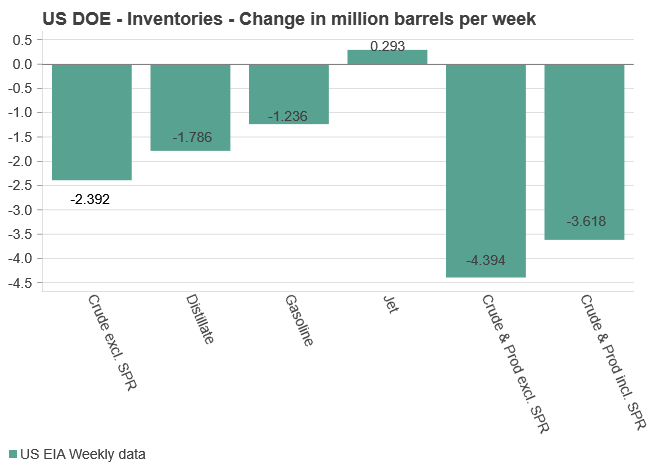

Analys
Increasing risk that OPEC+ will unwind the last 1.65 mb/d of cuts when they meet on 7 September

Pushed higher by falling US inventories and positive Jackson Hall signals. Brent crude traded up 2.9% last week to a close of $67.73/b. It traded between $65.3/b and $68.0/b with the low early in the week and the high on Friday. US oil inventory draws together with positive signals from Powel at Jackson Hall signaling that rate cuts are highly likely helped to drive both oil and equities higher.

Ticking higher for a fourth day in a row. Bank holiday in the UK calls for muted European session. Brent crude is inching 0.2% higher this morning to $67.9/b which if it holds will be the fourth trading day in a row with gains. Price action in the European session will likely be quite muted due to bank holiday in the UK today.
OPEC+ is lifting production but we keep waiting for the surplus to show up. The rapid unwinding of voluntary cuts by OPEC+ has placed the market in a waiting position. Waiting for the surplus to emerge and materialize. Waiting for OECD stocks to rise rapidly and visibly. Waiting for US crude and product stocks to rise. Waiting for crude oil forward curves to bend into proper contango. Waiting for increasing supply of medium sour crude from OPEC+ to push sour cracks lower and to push Mid-East sour crudes to increasing discounts to light sweet Brent crude. In anticipation of this the market has traded Brent and WTI crude benchmarks up to $10/b lower than what solely looking at present OECD inventories, US inventories and front-end backwardation would have warranted.
Quite a few pockets of strength. Dubai sour crude is trading at a premium to Brent crude! The front-end of the crude oil curves are still in backwardation. High sulfur fuel oil in ARA has weakened from parity with Brent crude in May, but is still only trading at a discount of $5.6/b to Brent versus a more normal discount of $10/b. ARA middle distillates are trading at a premium of $25/b versus Brent crude versus a more normal $15-20/b. US crude stocks are at the lowest seasonal level since 2018. And lastly, the Dubai sour crude marker is trading a premium to Brent crude (light sweet crude in Europe) as highlighted by Bloomberg this morning. Dubai is normally at a discount to Brent. With more medium sour crude from OPEC+ in general and the Middle East specifically, the widespread and natural expectation has been that Dubai should trade at an increasing discount to Brent. the opposite has happened. Dubai traded at a discount of $2.3/b to Brent in early June. Dubai has since then been on a steady strengthening path versus Brent crude and Dubai is today trading at a premium of $1.3/b. Quite unusual in general but especially so now that OPEC+ is supposed to produce more.
This makes the upcoming OPEC+ meeting on 7 September even more of a thrill. At stake is the next and last layer of 1.65 mb/d of voluntary cuts to unwind. The market described above shows pockets of strength blinking here and there. This clearly increases the chance that OPEC+ decides to unwind the remaining 1.65 mb/d of voluntary cuts when they meet on 7 September to discuss production in October. Though maybe they split it over two or three months of unwind. After that the group can start again with a clean slate and discuss OPEC+ wide cuts rather than voluntary cuts by a sub-group. That paves the way for OPEC+ wide cuts into Q1-26 where a large surplus is projected unless the group kicks in with cuts.
The Dubai medium sour crude oil marker usually trades at a discount to Brent crude. More oil from the Middle East as they unwind cuts should make that discount to Brent crude even more pronounced. Dubai has instead traded steadily stronger versus Brent since late May.
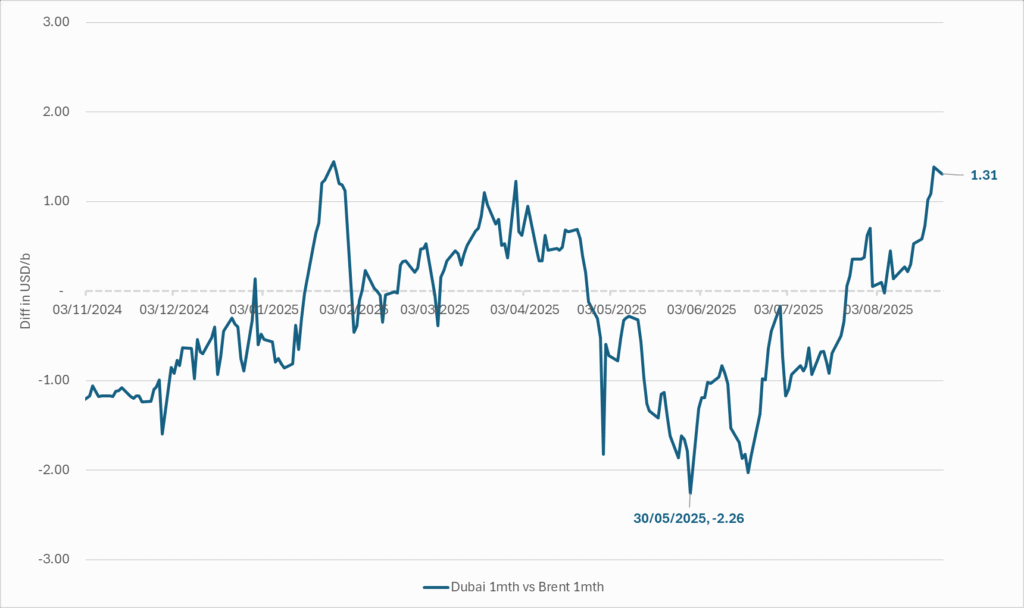
The Brent crude oil forward curve (latest in white) keeps stuck in backwardation at the front end of the curve. I.e. it is still a tight crude oil market at present. The smile-effect is the market anticipation of surplus down the road.
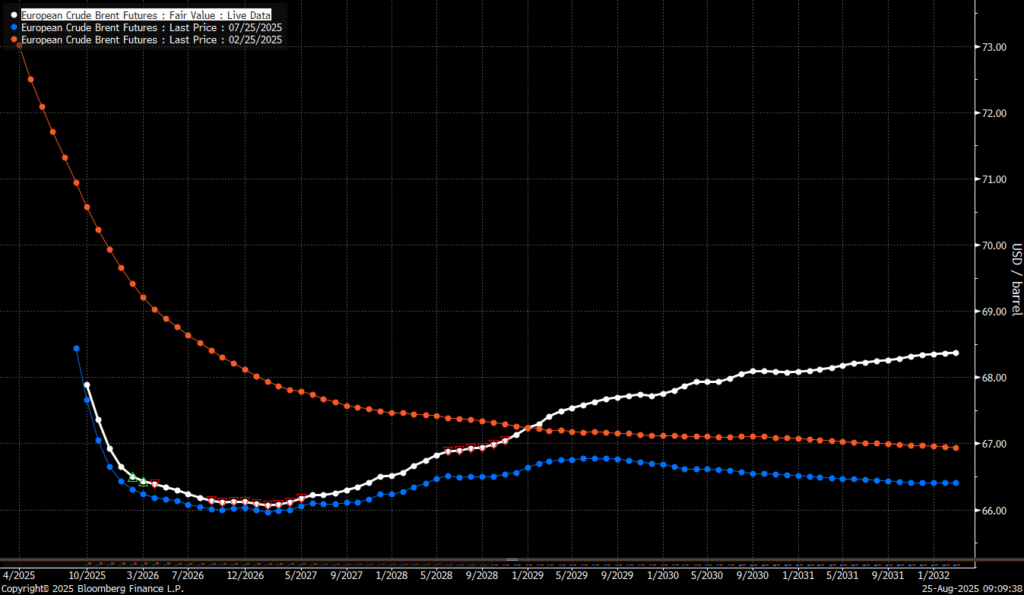
Analys
Brent edges higher as India–Russia oil trade draws U.S. ire and Powell takes the stage at Jackson Hole

Best price since early August. Brent crude gained 1.2% yesterday to settle at USD 67.67/b, the highest close since early August and the second day of gains. Prices traded to an intraday low of USD 66.74/b before closing up on the day. This morning Brent is ticking slightly higher at USD 67.76/b as the market steadies ahead of Fed Chair Jerome Powell’s Jackson Hole speech later today.

No Russia/Ukraine peace in sight and India getting heat from US over imports of Russian oil. Yesterday’s price action was driven by renewed geopolitical tension and steady underlying demand. Stalled ceasefire talks between Russia and Ukraine helped maintain a modest risk premium, while the spotlight turned to India’s continued imports of Russian crude. Trump sharply criticized New Delhi’s purchases, threatening higher tariffs and possible sanctions. His administration has already announced tariff hikes on Indian goods from 25% to 50% later this month. India has pushed back, defending its right to diversify crude sourcing and highlighting that it also buys oil from the U.S. Moscow meanwhile reaffirmed its commitment to supply India, deepening the impression that global energy flows are becoming increasingly politicized.
Holding steady this morning awaiting Powell’s address at Jackson Hall. This morning the main market focus is Powell’s address at Jackson Hole. It is set to be the key event for markets today, with traders parsing every word for signals on the Fed’s policy path. A September rate cut is still the base case but the odds have slipped from almost certainty earlier this month to around three-quarters. Sticky inflation data have tempered expectations, raising the stakes for Powell to strike the right balance between growth concerns and inflation risks. His tone will shape global risk sentiment into the weekend and will be closely watched for implications on the oil demand outlook.
For now, oil is holding steady with geopolitical frictions lending support and macro uncertainty keeping gains in check.
Oil market is starting to think and worry about next OPEC+ meeting on 7 September. While still a good two weeks to go, the next OPEC+ meeting on 7 September will be crucial for the oil market. After approving hefty production hikes in August and September, the question is now whether the group will also unwind the remaining 1.65 million bpd of voluntary cuts. Thereby completing the full phase-out of voluntary reductions well ahead of schedule. The decision will test OPEC+’s balancing act between volume-driven influence and price stability. The gathering on 7 September may give the clearest signal yet of whether the group will pause, pivot, or press ahead.
-

 Nyheter3 veckor sedan
Nyheter3 veckor sedanOmgående mångmiljardfiasko för Equinors satsning på Ørsted och vindkraft
-
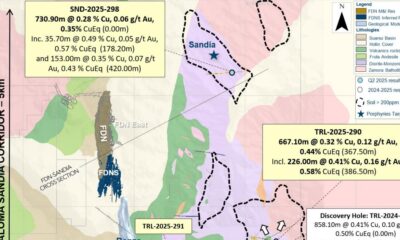
 Nyheter4 veckor sedan
Nyheter4 veckor sedanLundin Gold hittar ny koppar-guld-fyndighet vid Fruta del Norte-gruvan
-

 Nyheter1 vecka sedan
Nyheter1 vecka sedanMeta bygger ett AI-datacenter på 5 GW och 2,25 GW gaskraftverk
-

 Nyheter3 veckor sedan
Nyheter3 veckor sedanGuld stiger till över 3500 USD på osäkerhet i världen
-

 Analys3 veckor sedan
Analys3 veckor sedanWhat OPEC+ is doing, what it is saying and what we are hearing
-

 Nyheter4 veckor sedan
Nyheter4 veckor sedanAlkane Resources och Mandalay Resources har gått samman, aktör inom guld och antimon
-
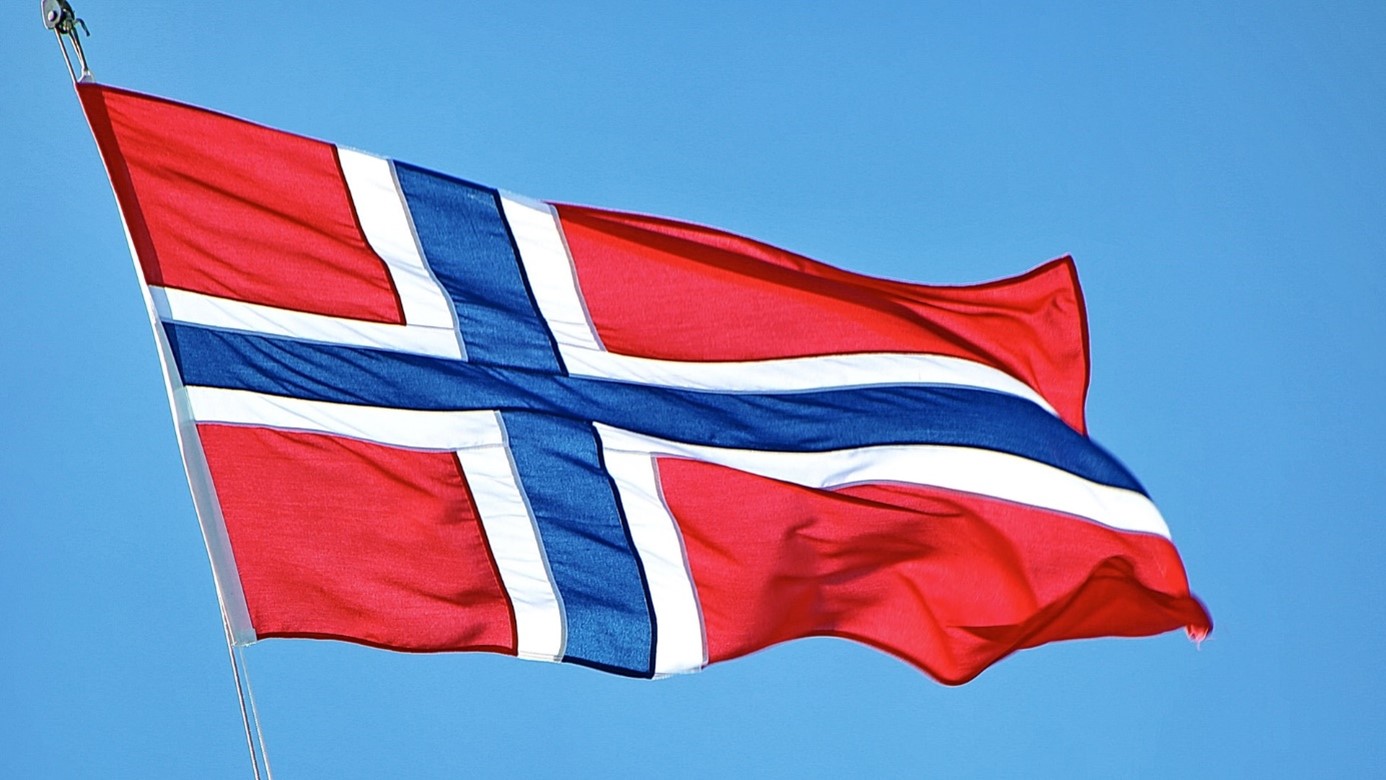
 Nyheter1 vecka sedan
Nyheter1 vecka sedanAker BP gör ett av Norges största oljefynd på ett decennium, stärker resurserna i Yggdrasilområdet
-

 Nyheter3 veckor sedan
Nyheter3 veckor sedanLyten, tillverkare av litium-svavelbatterier, tar över Northvolts tillgångar i Sverige och Tyskland



